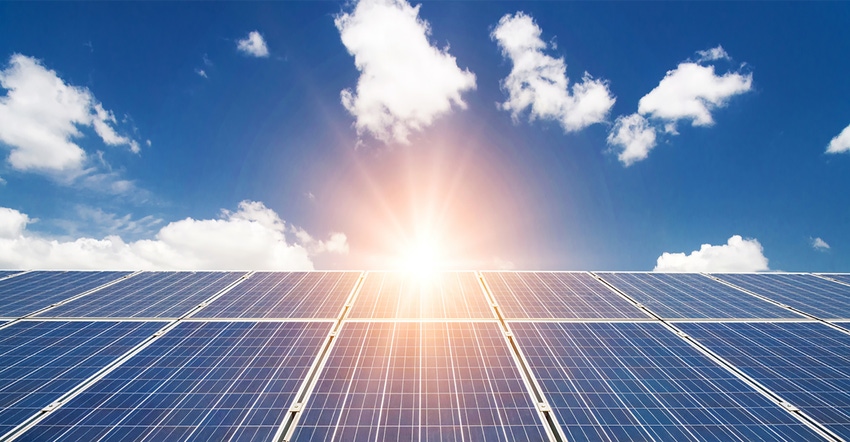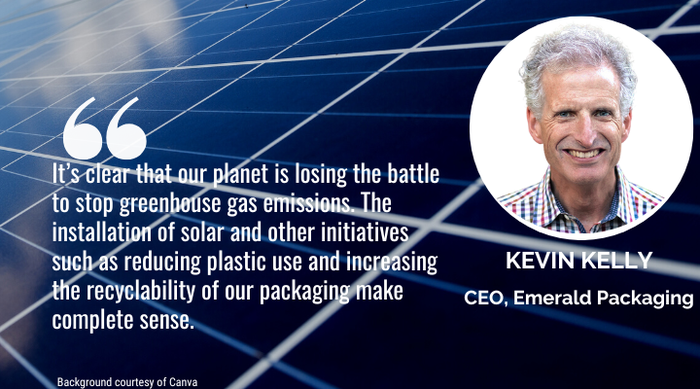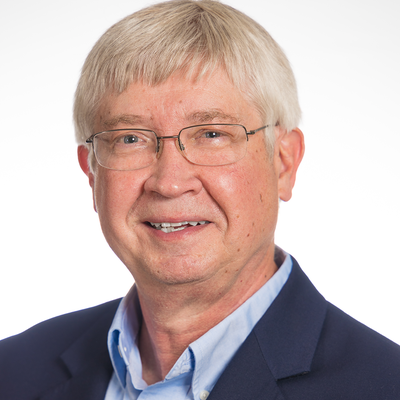Flexible Packaging Powerhouse Switches to Solar Power
Solar panel installations at two plants will cut CA-based Emerald Packaging’s emissions by the equivalent of more than 47 million pounds of coal burned over 25 years.

The stars aligned for West Coast-based Emerald Packaging, the leading flexible packaging provider for US produce brands, to finally invest in solar energy to power the company’s two adjacent manufacturing facilities in Union City, CA. It’s a decision that Kevin Kelly, chief executive officer, has considered for the past 10 years.
“Two things came together that finally pushed me over the edge,” Kelly tells us, admitting that he’s lost track of the number of times the operations team was asked to check pricing.
“First, [energy provider] PG&E raised its rates for businesses so high — 20% last year with the threat of another 30% this year — the payback dropped from four or five years to three years.
“Second, since last spring the alarm bells have been sounding louder and louder, with speakers at every major conference saying we’re nearly at the point of no return. I felt if we could do something to reduce greenhouse gas, let’s do it.”

The slightly larger of the two side-by-side facilities — 100,000 sq ft vs 90,000 sq ft for the other — will go live with solar in the first half of 2023 while the second solar facility will power up in mid-2023.
It could be said that other “stars” served as wild-card factors to prompt fast-tracking the decision.
“Given rising energy costs, the price of waiting is likely higher than the price of just doing it,” Kelly explains. “One major surprise was that the roof on one of the buildings needed replacing, which added an unexpected $1 million cost. We would have had to replace it anyway in the next few years anyway, so it’s not something we could have avoided. It just wasn’t considered in our initial plans.”
Forecast is for plenty of sunshine and savings.
The solar installation will cut Emerald Packaging’s emissions by more than the equivalent of 47 million pounds of coal burned and will help reduce energy spend at this site by $12 million over 25 years.
According to documentation Kelly provided, the expected first year power generation is nearly 2,500,000 kilowatt hours (kWh) of direct current. The solar provider’s project cost was about $3,250,000.
When asked about the anticipated amount of sunshine expected amidst a period of catastrophic rainfall across the state, Kelly cites statistics that forecast about 260 days of sunshine.
Any assumptions made about generous support from state grants or subsidies would be incorrect.
“California isn’t that generous,” Kelly responds. “The state focuses more on plastic waste than greenhouse-gas reduction.”
Any solar energy collected will be used immediately as Emerald does not have any battery storage or the like. “We have to wait on that, the economics are not quite there yet,” he points out.
Kelly's advice? “Keep investing, especially in green technologies. [We all] must think about the planet, and in some cases, even save money doing so.”
The move to greener energy fits into the company’s overarching sustainability plans that have earned it California Green Business certification. It’s also one of the few flexible packaging companies in the US to become an Ellen MacArthur Foundation signatory.
“Our company is committed to playing its part in sustainability and mobilizing a shift towards a circular economy for plastics,” says Kelly explains. “It’s clear that our planet is losing the battle to stop greenhouse gas emissions. We need to step up in any way we can. The installation of solar and other initiatives such as reducing plastic use and increasing recyclability of our packaging make complete sense.”
The flexible packaging supplier's customers include Dole, Fresh Express, Organic Girl, Del Monte, Snow Crest, and American Licorice Co.
About the Author(s)
You May Also Like




